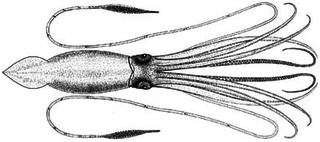
The giant squid is a species of deep-ocean dwelling squid in the family Architeuthidae. It can grow to a tremendous size, offering an example of abyssal gigantism: recent estimates put the maximum size at around 12–13 m (39–43 ft) for females and 10 m (33 ft) for males, from the posterior fins to the tip of the two long tentacles. The mantle of the giant squid is about 2 m long, and the length of the squid excluding its tentacles rarely exceeds 5 m (16 ft). Claims of specimens measuring 20 m (66 ft) or more have not been scientifically documented.
Liguriella is a genus of glass squids, the genus is probably monotypic, the only species being Liguriella podophthalma. The other named species Liguriella pardus, which was described by S. Stillman Berry in 1916, is cited as a taxon inquirendum but it is suggested that there may be in fact more than one species and there are species yet to be described.
Moroteuthopsis longimana, also known as the giant warty squid or longarm octopus squid, is a large species of hooked squid. It attains a mantle length of at least 85 cm and probably over 1.15 m. The largest complete specimen of this species, measuring 2.3 m in total length, was found in Antarctica in 2000.

Histioteuthis reversa, commonly known as the reverse jewel squid or the elongate jewel squid, is a species of cock-eyed squid, so called because the eyes are dissimilar. It occurs at moderate depths in the Atlantic Ocean and the Mediterranean Sea. It is also known from the Indian Ocean.
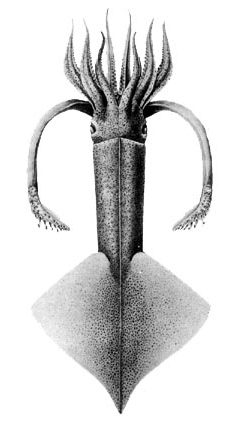
Onychoteuthis is a genus of squid in the family Onychoteuthidae. The type species is Onychoteuthis bergii. While the genus is found worldwide in tropical and subtropical oceans, they can also occur in the North Pacific Ocean. There were previously considered to be four species in the genus but there are now considered to be roughly 10. These squid are frequently observed in the surface waters at night and they are often caught using dipnet at nightlight stations. The young squid are usually the only specimens captured using standard midwater trawls, the older squid are apparently able to avoid the trawls. They can, however be collected from the air as individuals are able to leap high out of the water, sometimes even landing on the deck of a ship.

The colossal squid is the largest member of its family Cranchiidae, the cockatoo or glass squids, with its second largest member being Megalocranchia fisheri. It is sometimes called the Antarctic cranch squid or giant squid and is believed to be the largest squid species in terms of mass. It is the only recognized member of the genus Mesonychoteuthis and is known from only a small number of specimens. The species is confirmed to reach a mass of at least 495 kilograms (1,091 lb), though the largest specimens—known only from beaks found in sperm whale stomachs—may perhaps weigh as much as 600–700 kilograms (1,300–1,500 lb), making it the largest known invertebrate. Maximum total length has been estimated between 10 metres (33 ft) and 14 metres (46 ft) but the former estimate is more likely. The colossal squid has the largest eyes of any known creature ever to exist, with an estimated diameter of 27–30 cm (11–12 in) to 40 cm (16 in) for the largest collected specimen.

Teuthowenia megalops, sometimes known as the Atlantic cranch squid, is a species of glass squid from the subarctic and temperate waters of the northern Atlantic Ocean. They are moderately sized squid with a maximum mantle length of 40 cm (16 in). Their very large eyes are the source for the specific name megalops. Like other members of the genus Teuthowenia, they are easily recognizable by the presence of three bioluminescent organs (photophores) on their eyeballs.
Brachioteuthis riisei is a species of squid in the family Brachioteuthidae.
Afrololigo mercatoris, commonly known as the Guinean thumbstall squid, is a small species of squid in the family Loliginidae from the eastern central Atlantic Ocean. It is the only species in the monotypic genus Afrololigo.

Taonius belone is a glass squid belonging to the genus Taonius from the family Cranchiidae. It occurs in the northern subtropical and in the tropical or equatorial waters of the Pacific Ocean and the Indian Ocean.
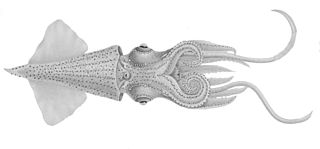
Enoploteuthis leptura, the hooked enope squid, is a species of squid from the family Enoploteuthidae. It is the type species of the genus Enoploteuthis, which is in turn the type genus of the Enoploteuthidae.

Gonatopsis borealis, the Boreopacific armhook squid, is a species of squid from the North Pacific Ocean. It is a member of the family Gonatidae. It is an abundant species which is currently caught mainly as a bycatch by fishing boats targeting other quarry. It is an important prey species for many commercially important species of fish, as well as for marine mammals.
Gonatopsis japonicus is a species of squid from the family Gonatidae. This species is restricted to the western North Pacific in the seas around the Japanese Archipelago.
Nototeuthis is a monotypic genus of squid, in the family Neoteuthidae. The only species in this genus is Nototeuthis dimegacotyle . This species is characterised by short tentacular clubs, less than 40% of the length of the mantle, and relatively long fins, which are approximately 60% of the mantle length. The tentacle clubs have two greatly enlarged suckers on distal portion of the manus, which distinguish N. dimegacotyle from other members of the Neoteuthidae. Few specimens of this species are currently known. Specimens have been collected from the south eastern Pacific Ocean, off Chile, between the Southern Subtropical and the Antarctic Polar frontal zones. This species is mesopelagic to bathypelagic and can be found from near the surface to a depth of ~500m.
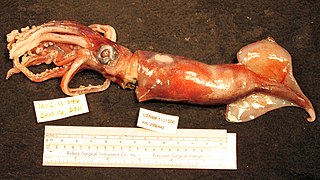
Ornithoteuthis antillarum, the Atlantic bird squid, is a species of flying squid from the family Ommastrephidae which is found in the warmer waters of the Atlantic Ocean. This species is an important component of the diet of many species of fish and of cetaceans. It is taken as a bycatch in fisheries but has the potential to be commercially important if appropriate fishing methods can be developed.
Ornithoteuthis volatilis, the shiny bird squid, is a squid from the subfamily Ommastrephinae, the flying squids, of the family Ommastrephidae part of the pelagic squid order Oegopsida. It is a tropical and sub-tropical species which is widely distributed in the Indo-Pacific oceans. It is slightly larger than the closely related species Ornithoteuthis antillarum of the Atlantic Ocean.
The Angolan flying squid is a species of squid from the subfamily Todarodinae, part of the family Ommastrephidae. Due to taxonomic confusion with the Antarctic flying squid the exact limits of its distribution are uncertain but it is thought to be restricted to waters off Southern Africa.
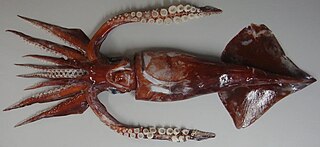
The Antarctic flying squid is a species of squid from the subfamily Todarodinae of the family Ommastrephidae, a family of pelagic squid from the order Oegopsida. It has a circumglobal distribution in the seas around the lower latitudes of the Southern Ocean.
The little flying squid is a species of squid, one of the arrow squids of the genus Todarodes, in the subfamily Todarodinae of the flying squid family Ommastrephidae. It is a small species from the waters around northern Australia and Indonesia.

The European flying squid is a species of squid from the continental slope and oceanic waters of the eastern Atlantic Ocean and the Mediterranean Sea. It is the type species of the genus Todarodes, the type genus of the subfamily Todarodinae of the pelagic squid family Ommastrephidae. It is a species which is targeted by some fisheries, although it is more often a bycatch.












